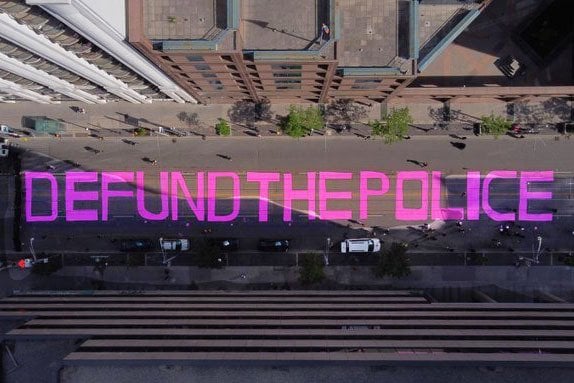
The Toronto Police Services Board held a virtual public meeting on Friday, June 19, its first since the police custody deaths of Regis Korchinski-Paquet in Toronto and George Floyd in the U.S. – and all the questions that the protests that followed have raised about police accountability. And it did not go well.
Some members of the public who were scheduled to speak on a host of issues, including police use of force and current systems in place to respond to people in a mental health crisis, experienced technical difficulties logging in to the meeting. Those were eventually resolved.
But the communication breakdown started before the meeting because of a report added to the agenda late in the game on June 17, with little notice to the public. That was by Board chair Jim Hart on “recommendations for the Board related to current events.”
According to a statement released by the Board, the report was to deal with recommendations from the Board’s Anti-Racism Advisory Panel, Mental Health and Addictions Advisory Panel and Mobile Crisis Intervention Team program, as well as “other matters.”
But the statement was unclear on what those “current events” or “other matters” were and members of the public who inquired were not told.
The report was eventually removed from the agenda on June 18 after numerous complaints that it was being tabled without the public being given an opportunity to see the document. The Board has now announced plans for a town hall scheduled for July 6 “to hear directly from the public on issues related to police accountability, reform and community safety priorities.” The details will be released closer to the date.
But as protestors gathered outside police headquarters for a noon-hour sit-in to call for the defunding of police, the divide between the public and those on the Board charged with oversight of policing has never seemed wider.
The Toronto Police Accountability Coalition (TPAC), headed by John Sewell, had written to the Board on June 12 asking to make a submission Friday “on some of the big issues the public has raised,” including “ending anti-Black and anti-Indigenous racism and reassigning various functions from the police to social service agencies.” TPAC’s letter urges the establishment of a committee to make recommendations to the Board on a future direction for the force before it decides to hire a new chief. (Mark Saunders announced he will be stepping down on July 31.)
But the Board rejected that idea, replying in a letter to TPAC that a discussion on those matters would be “premature,” since the Board has yet to make a decision on the selection process that will be used to choose a new chief.
At Friday’s meeting, Sewell turned his sights instead on making a case to disarm the police.
He referenced statistics in the Corporate Risk Management Report before the Board showing Toronto police officers discharged their firearms a total of 23 times in 2019. According to the report, only one of those involved a suspect, and a handful of others involved suspect vehicles. There were two accidental discharges. The rest involved animals. (According to the report, guns were drawn and pointed by police 1,015 times in 2019.)
Sewell noted that the cost of ammunition in 2019, meanwhile, was some $2.4 million. “That means that for every time a gun was discharged,” he told the Board, “it costs about $100,000… a staggering amount.”
Sewell highlighted similar numbers in the use of tasers, which cost the force $1.3 million last year and some $700,000 in 2020, not including training. Tasers were used 132 times in 2019.
“One has to question why rank and file officers have guns,” says Sewell, “because they are used so rarely.”
Sewell argued that only Emergency Task Force officers should be armed. And that Toronto police should be moving towards what he describes as a “policing by consent” model used in the UK, where most frontline officers do not carry guns.
“The Board could show a lot of leadership if it said it was going to disarm the Toronto police. They literally don’t need their guns,” Sewell concluded.
But no one on the Board took him up on that. Nor was the chief asked by Board chair Hart to respond.
Vice-chair Marie Moliner did say, however, that she planned to bring the issue forward as part of the Board’s police reform discussions.
But while the Board seems reluctant to discuss the issue of disarming police, it has signalled that it does plan to move ahead with body-worn cameras.
There, too, TPAC and others have expressed concerns about costs – and estimated $85 million over 10 years, not including the $20 million required to store video. TPAC notes that each officer would also need “about two hours during every shift to upload, classify and redact the videos made that day” at a cost of up to $20,000 per officer per year.
Whether body-worn cameras will help increase police transparency and accountability has also been brought into question. The Toronto police’s own pilot concluded in 2016 that “there was no significant incident or situation that arose that would have provided an opportunity for the body-worn cameras and associated video to demonstrate value, or lack thereof, for police accountability and public trust.”
The report concludes that “the quantitative results were not compelling. No cases with body-worn camera evidence went to court, so it is impossible to assess the use of the cameras in court.” Also, “video corruption was a major technical issue” and recovery of the video was not always successful.
The Board seems intent on moving forward nonetheless with a proposal for the purchase of the cameras slated to be tabled at its next meeting on July 30.
@nowtoronto












